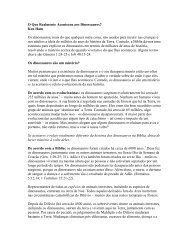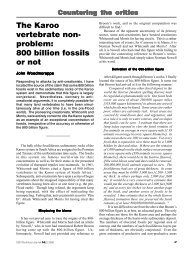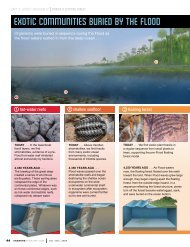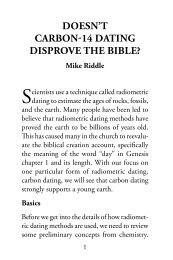Determining the Ark Kinds - Answers in Genesis
Determining the Ark Kinds - Answers in Genesis
Determining the Ark Kinds - Answers in Genesis
Create successful ePaper yourself
Turn your PDF publications into a flip-book with our unique Google optimized e-Paper software.
200<br />
was ga<strong>the</strong>red could bias <strong>the</strong> results. In <strong>the</strong> case of<br />
landfowl (Galliformes), <strong>the</strong> dataset was <strong>in</strong>tended<br />
to divide <strong>the</strong> birds up for taxonomic purposes. This<br />
seems a reasonable explanation for why <strong>the</strong> statistical<br />
tests based on that dataset divided birds that were<br />
connected by hybrid data.<br />
To some, us<strong>in</strong>g sequence data may seem more<br />
objective. Certa<strong>in</strong>ly identify<strong>in</strong>g sequences is objective.<br />
It is <strong>the</strong> <strong>in</strong>terpretation that is not. How does one<br />
dist<strong>in</strong>guish between sequences that are <strong>the</strong> same<br />
because two creatures are from <strong>the</strong> same k<strong>in</strong>d and<br />
sequences that are <strong>the</strong> same because God created <strong>the</strong>m<br />
<strong>the</strong> same <strong>in</strong> two different k<strong>in</strong>ds? Why do differences<br />
exist? Are <strong>the</strong>y simply variability God placed <strong>in</strong> one<br />
created k<strong>in</strong>d at Creation? Are <strong>the</strong>y differences that<br />
have arisen with<strong>in</strong> a k<strong>in</strong>d s<strong>in</strong>ce Creation? Are <strong>the</strong>y<br />
created differences between different k<strong>in</strong>ds? Are <strong>the</strong>y<br />
differences that have arisen between two different<br />
created k<strong>in</strong>ds that orig<strong>in</strong>ally had identical or very<br />
similar sequences <strong>in</strong> a particular region? The bottom<br />
l<strong>in</strong>e is that we don’t have enough understand<strong>in</strong>g<br />
of genetics to understand <strong>the</strong> significance of most<br />
sequence data.<br />
Once <strong>the</strong> modern descendants of <strong>the</strong> <strong>Ark</strong> k<strong>in</strong>ds<br />
are determ<strong>in</strong>ed, we need to use this <strong>in</strong>formation<br />
to <strong>in</strong>fer what <strong>the</strong> actual pair on <strong>the</strong> <strong>Ark</strong> may have<br />
looked like. One th<strong>in</strong>g that is evident when look<strong>in</strong>g<br />
at animals <strong>in</strong> <strong>the</strong> world today, many have specialized<br />
to live <strong>in</strong> specific niches. There are hares that live <strong>in</strong><br />
<strong>the</strong> arctic, o<strong>the</strong>rs that live <strong>in</strong> <strong>the</strong> desert, and o<strong>the</strong>rs <strong>in</strong><br />
<strong>in</strong>termediate climates. There are cattle (for example,<br />
<strong>the</strong> yak) that can withstand high altitudes and cold<br />
climates; <strong>the</strong>re are o<strong>the</strong>r cattle (for example, zebu) that<br />
are adapted to live <strong>in</strong> hot, arid climates. We also see<br />
specialization <strong>in</strong> domestic animals, where some cattle<br />
have been bred for milk production and o<strong>the</strong>rs have<br />
been bred for beef production. Given <strong>the</strong>se trends, <strong>the</strong><br />
<strong>Ark</strong> k<strong>in</strong>ds would be relatively unspecialized animals<br />
that fit nicely <strong>in</strong>to <strong>the</strong> cognitum of <strong>the</strong> created k<strong>in</strong>d.<br />
Just as build<strong>in</strong>g <strong>the</strong> <strong>Ark</strong> was a monumental task,<br />
so our task to determ<strong>in</strong>e <strong>the</strong> <strong>Ark</strong> k<strong>in</strong>ds is monumental<br />
as well. We clearly recognize that <strong>in</strong> many ways<br />
God has prepared us for this task. Yet we are also<br />
keenly aware that to do this task well we need power,<br />
strength, wisdom, <strong>in</strong>sight and perseverance that only<br />
our awesome, sovereign God can give us. For this,<br />
your prayers would be much appreciated.<br />
When we are done, we will not have all <strong>the</strong> answers<br />
regard<strong>in</strong>g created k<strong>in</strong>ds, but we hope to have made<br />
a substantial contribution to creation research that<br />
can serve as a strong resource for future research<br />
on created k<strong>in</strong>ds. Beyond this we pray that this<br />
<strong>in</strong>formation will be used to help people understand<br />
that God’s Word is trustworthy. May it be used to play<br />
a role <strong>in</strong> many com<strong>in</strong>g to know Christ and liv<strong>in</strong>g fully<br />
for His honor and glory.<br />
J. K. Lightner, T. Hennigan, G. Purdom, and B. Hodge<br />
Soli Deo Gloria!<br />
References<br />
ADW. 2008. Retrieved from http://animaldiversity.ummz.<br />
umich.edu/site/<strong>in</strong>dex.html.<br />
Brophy, T. R. 2008. A baram<strong>in</strong>ological analysis of <strong>the</strong> landfowl<br />
(Aves: Galliformes). Lecture presented at <strong>the</strong> 7th BSG<br />
conference, Pittsburg, Pennsylvania.<br />
Brophy, T. R., and P. A. Kramer. 2007. Prelim<strong>in</strong>ary results<br />
from a baram<strong>in</strong>ological analysis of <strong>the</strong> mole salamanders<br />
(Caudata: Ambystomatidae). Occasional papers of <strong>the</strong> BSG<br />
10:10–11.<br />
Kelk, D. A., C. J. Gartley, B. C. Buckrell, and W. A. K<strong>in</strong>g. 1997.<br />
The <strong>in</strong>terbreed<strong>in</strong>g of sheep and goats. The Canadian<br />
Veter<strong>in</strong>ary Journal 38, no. 4:235–237.<br />
Lightner, J. K. 2006. Identification of species with<strong>in</strong> <strong>the</strong> sheepgoat<br />
k<strong>in</strong>d (Tsoan monobaram<strong>in</strong>), Journal of Creation 20,<br />
no. 3:61–65.<br />
Lightner, J. K. 2007. Identification of species with<strong>in</strong> <strong>the</strong><br />
cattle monobaram<strong>in</strong> (k<strong>in</strong>d). Journal of Creation 21, no. 1:<br />
119–122.<br />
L<strong>in</strong>e, P. 2010. Gautengensis vs sediba: A battle for supremacy<br />
amongst ‘apeman’ contenders, but nei<strong>the</strong>r descended<br />
from Adam. Retrieved from http://creation.com/homogautengensis.<br />
Lubenow, M. 2010. The problem with Australopi<strong>the</strong>cus sediba.<br />
<strong>Answers</strong> <strong>in</strong> Depth 5:138–140. Retrieved from http://www.<br />
answers<strong>in</strong>genesis.org/articles/aid/v5/n1/problem-withaustralopi<strong>the</strong>cus-sediba.<br />
Menton, D. N., A. Habermehl, and D. A. DeWitt. 2010.<br />
Baram<strong>in</strong>ological analysis places Homo habilis, Homo<br />
rudolfensis, and Australopi<strong>the</strong>cus sediba <strong>in</strong> <strong>the</strong> human<br />
holobaram<strong>in</strong>: Discussion. <strong>Answers</strong> Research Journal<br />
3:153–158.<br />
McConnachie, M. and T. R. Brophy. 2008. A baram<strong>in</strong>ological<br />
analysis of <strong>the</strong> landfowl (Aves: Galliformes). Occasional<br />
papers of <strong>the</strong> BSG 11:9–10.<br />
Patil, S. and S. Totey. 2003. Developmental failure of hybrid<br />
embryos generated by <strong>in</strong> vitro fertilization of water buffalo<br />
(Bubalus bubalis) oocyte with bov<strong>in</strong>e spermatozoa.<br />
Molecular Reproduction and Development 64, no. 3:<br />
360–368.<br />
Sanders, R. W. and K. P. Wise. 2003. The cognitum: A<br />
perception-dependent concept needed <strong>in</strong> baram<strong>in</strong>ology.<br />
In Proceed<strong>in</strong>gs of <strong>the</strong> Fifth International Conference on<br />
Creationism, ed. R. L. Ivey, pp. 445–456. Pittsburgh,<br />
Pennsylvania: Creation Science Fellowship.<br />
Scherer, S. 1993. Typen des lebens, pp. 11–30. Berl<strong>in</strong>, Germany:<br />
Pascal-Verlag.<br />
Turner, K. J. 2009. The k<strong>in</strong>d-ness of God:A <strong>the</strong>ological<br />
reflection of mîn, “k<strong>in</strong>d”. In CORE Issues <strong>in</strong> Creation no. 5,<br />
ed. T. C. Wood and P. A. Garner, pp. 31–64. Eugene, Oregon:<br />
Wipf and Stock.<br />
Williams, P. J. 1997. What does m<strong>in</strong> mean? CEN Tech J. 11,<br />
no. 3:344–352.<br />
Wilson, G. 2010. Classic multidimensional scal<strong>in</strong>g isn’t <strong>the</strong><br />
s<strong>in</strong>e qua non of baram<strong>in</strong>ology. <strong>Answers</strong> <strong>in</strong> Depth 5:173–175.<br />
Retrieved from http://www.answers<strong>in</strong>genesis.org/articles/<br />
aid/v5/n1/cmds-baram<strong>in</strong>ology.<br />
Wood, T. C., K. P. Wise, R. Sanders, and N. Doran. 2003. A<br />
ref<strong>in</strong>ed baram<strong>in</strong> concept. Occasional papers of <strong>the</strong> BSG







